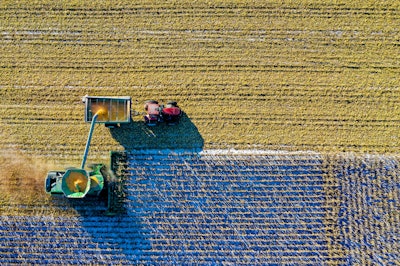
As the 2025 harvest approaches, grain cooperatives across the Midwest are walking a tightrope. While improved soil moisture and strong yield expectations (especially for corn) offer glimmers of optimism, the weight of weak export demand, cost inflation and chronic labor shortages is reshaping how operators plan, hire, bid and survive.
In conversations with Feed & Grain, co-op leaders reveal how they’re confronting the realities of the current cycle, characterized by lean margins, increasing risk, staffing challenges and skyrocketing insurance premiums.
Grain storage and marketing behavior
In Kansas and across the U.S., grain operators are battling weak basis and sluggish export demand — especially for milo and corn.
“We had zero (milo export business) and that absolutely ruined our milo and corn basis and profitability,” said Mike Schmidt, chief operating officer of grain operations for Pride Ag Resources. He added that while wheat has seen a slight export recovery, the market is far from booming.
Mark Paul, immediate past chairman of the Kansas Grain and Feed Association and general manager of Cloud County Cooperative Elevator, echoed the concern, noting how volatility and unpredictable world events have made it harder to forecast sales and profitability.
Labor availability and workforce development
While labor shortages are nothing new in rural grain handling, 2025 continues the trend with no clear end in sight.
“Labor is one of the worst challenges that we have as managers,” Schmidt said. “We have been running short on staff ever since COVID, and we have never recovered, and I don't know that we ever will recover.”
Paul, however, has seen hints of progress.
“We recently added six people to our staff in one week,” Paul said. “They came from bigger surrounding cities, where they grew tired of what they were doing.”
He credits his co-op’s proactive approach to bringing in new talent by offering competitive benefits and a clearer sense of purpose.
Doug Biswell, president and general manager of Jackson Farmers Inc., added further perspective.
“Finding people that want to work and work the hours necessary to service the growers at harvest is a challenge, and I do not see that situation ever getting any better.”
Biswell said wage expectations have stabilized at the entry level but continue to climb for CDL drivers and custom applicators.
Despite participating in internship and outreach programs, "our company has seen no results from workforce development programs, internships or apprenticeships," Biswell said.
Retention now depends on competitive wages, strong benefits and open communication.
“We offer 401(k) match, co-op retirement, and our vacation and paid time off benefits are better than any other place that I have ever worked," Biswell said.
Paul has also focused on outreach to younger generations, offering educational visits for sixth grade students to introduce them to ag careers early on.
Ethanol and the crush cushion
Though much of the industry focus has been on soybean crush expansion, Kansas co-ops are seeing a benefit from ethanol. Schmidt says local ethanol demand saved their operation last year when milo exports evaporated.
“If we wouldn’t have had the ethanol in our area, I don’t know what we would have done with all the milo last year,” Schmidt said.
With milo exports disappearing, ethanol provided a vital domestic outlet and prevented an even deeper pricing crisis.
Looking ahead, tracking domestic crush dynamics will be valuable to monitor oversupply and price volatility in meal and oil markets.
Rising cost of insurance and doing business
The rising cost of property insurance has also become a critical concern. Co-op leaders cited premium hikes of 50% or more, plus higher deductibles. With so few insurers in the market, co-ops are forced to accept high premiums and limited coverage just to stay protected.
"We’re paying more for less coverage, and there's no easy fix," said Paul.
In response, co-ops are evaluating captive insurance options and weighing mergers to expand scale and financial resilience.
"That’s why you’re seeing more co-ops consolidate,” said Schmidt. “You need buying power and a wider footprint to spread these costs."
Meanwhile, everyday costs — from motors to facility repairs — continue to rise.
Cost crunch and the margin squeeze
High interest rates and inflation continue to strain operational budgets. Paul calls it a return to 1980s-style financing challenges.
“On a daily basis, we calculate our costs per bushel for everything and we micromanage everything to the cent,” Paul said. “It's amazing to see what has happened over the last five years with the droughts, COVID and other world events — we're in a world we've never been in before.”
Schmidt added: “It has gotten out of control with what it costs to do an upgrade or buy a 30-horsepower motor to run an elevator leg or a drag conveyor. Those costs have surged in the last five years, while we're operating on the same margins we did 35 years ago.”
As the discrepancy between rising costs and flat revenue persists, cost control is essential. Paul said co-ops, like Cloud County Cooperative Elevator, are coping by sharpening their data analysis and utilizing artificial intelligence (AI)-based budgeting tools to pinpoint overspending.
These tools can help teams evaluate historical utility and insurance costs to improve decisions.
Shifting farmer behavior and price resistance
While co-ops are making moves to secure grain, farmer selling behavior remains cautious and selective.
"There’s very little forward selling,” said Schmidt. “They’re hanging on until we get a futures rally.”
He noted that the return of futures carry is helpful, but current prices aren't moving the needle enough for many growers.
Dr. James Mintert, professor emeritus at Purdue University and co-founder of the Ag Economy Barometer, said the farmer sentiment data reflect this pullback.
“The overall measure of sentiment did decline ... and the biggest driver was the index of future expectations,”
Farmers’ future expectations fell 18 points in the June 2025 Ag Barometer report.
Mintert attributed this to the increasing pessimism producers feel about trade prospects and future growth opportunities. While subsoil moisture in Kansas is encouraging and yield potential looks strong, market conditions are not yet incentivizing early movement of grain.
Policy and export outlook
Co-op leaders and producers alike are keeping close tabs on trade negotiations and policy direction under the new administration.
Schmidt expressed hope that tariff-driven strategies would ultimately lead to fairer deals.
“I think the tariffs are trying to make fair trade, and I think it’s going to be very beneficial to us,” Schmidt said.
Mintert's data, however, reveals a more nuanced view among farmers.
"The percentage of people who said they think exports will actually decrease did rise ... from 12% to 16%," Mintert said.
He cited trade uncertainty as a major contributor to falling confidence. He noted that although many farmers believe tariffs may work in the long term, they are also increasingly skeptical of the benefits of free trade.
“The majority of people now are telling us that they no longer strongly agree with free trade as beneficial to U.S. agriculture," Mintert said.
He described the current mood as one of volatility, where each new trade headline has the potential to sway marketing behavior.
Looking ahead
While there’s hope for a solid fall crop, operators remain cautious. Paul said we’re in a world we’ve never seen with regard to climate change, economic volatility and political uncertainty.
According to Paul, some actions are within a grain operators’ control.
“No. 1 is to make sure you have space available, so you can take care of the customer,” Paul said. “That’s a serious risk if you can’t get them in the door."
Others include having an accident-free facility during harvest, properly safety training staff, inspecting all equipment and maintaining a good reputation with your insurance company and banker.
As harvest 2025 nears, co-ops are rebalancing risk, redefining success and digging in for the season ahead.
















